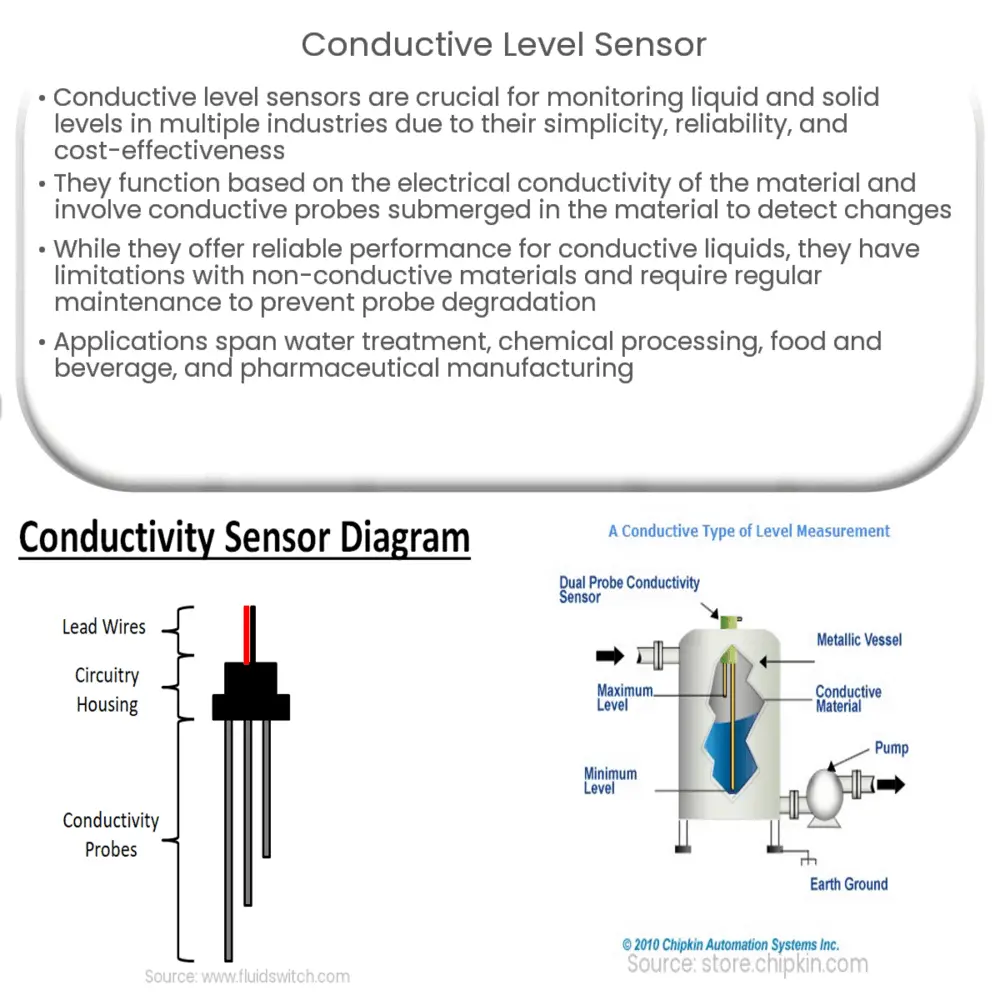Conductive level sensors accurately measure liquid levels in tanks using electrical conductivity, offering a reliable, cost-effective solution for various industries.

Conductive Level Sensor: An Overview
Introduction
Level sensors play a crucial role in various industries, ensuring the efficient and accurate monitoring and control of liquid and solid levels in containers and tanks. Among the different types of level sensors available, conductive level sensors stand out for their simplicity, reliability, and cost-effectiveness. This article provides an in-depth look at conductive level sensors, exploring their working principles, advantages, disadvantages, and applications.
Working Principle
Conductive level sensors operate based on the electrical conductivity of the material being measured. These sensors consist of a series of conductive probes or electrodes immersed in the material, typically a liquid. When the material reaches a specific level, it creates an electrical connection between the probes. This change in conductivity is detected and converted into a level measurement by the sensor’s control unit.
The sensor’s control unit typically uses a low-voltage, alternating current (AC) to minimize the risk of electrolysis, which can cause corrosion and degradation of the probes over time. The control unit can be configured to monitor different levels, such as high or low, by adjusting the number and placement of the probes within the container.
Advantages
- Simple design: Conductive level sensors have a straightforward design with few moving parts, making them easy to install, maintain, and troubleshoot.
- Cost-effective: These sensors are relatively inexpensive compared to other level measurement technologies, making them an attractive option for budget-conscious applications.
- Reliable performance: Conductive level sensors provide accurate and consistent measurements, even in challenging environments or when dealing with corrosive or viscous materials.
- Versatile applications: These sensors can be used to monitor various materials, including water, acids, alkalis, and many other conductive liquids.
Disadvantages
- Material limitations: Conductive level sensors are limited to conductive materials, meaning they cannot be used with non-conductive liquids, such as oil, or with solid materials.
- Electrolysis and probe degradation: Although the use of low-voltage AC helps minimize electrolysis, the probes can still experience wear and corrosion over time, especially when dealing with aggressive materials.
- Contamination sensitivity: The accuracy of conductive level sensors can be affected by the buildup of contamination or deposits on the probes, requiring regular cleaning and maintenance to ensure reliable operation.
Applications
Conductive level sensors are widely used in various industries and applications, including:
- Water and wastewater treatment: These sensors are commonly used to monitor and control water levels in storage tanks, sumps, and reservoirs, as well as to detect overflows or leaks.
- Chemical processing: Conductive level sensors can accurately measure the levels of various conductive chemical solutions, including acids, alkalis, and other corrosive liquids.
- Food and beverage: These sensors can be used to monitor and control levels of conductive liquid products, such as juices, sauces, and syrups, in tanks and containers.
- Pharmaceutical manufacturing: Conductive level sensors can be used to measure levels of conductive liquids, such as saline solutions and liquid medicines, ensuring consistent product quality and safety.
Selection Considerations
When choosing a conductive level sensor for a specific application, several factors should be considered:
- Material compatibility: Ensure that the sensor’s probes are made of a material that is resistant to the chemicals and conditions of the measured material. Stainless steel and titanium are common probe materials, but other options may be necessary for highly corrosive or aggressive liquids.
- Probe length: The length of the probes should be sufficient to reach the desired measurement range within the container or tank. Custom probe lengths are often available to accommodate unique applications.
- Number of levels: Consider the number of levels that need to be monitored or controlled, as this will determine the number of probes required. Some conductive level sensors can support multiple probes, allowing for more complex control schemes.
- Mounting and installation: Select a sensor with a suitable mounting configuration for the specific application, such as top-mounted or side-mounted sensors, to ensure proper installation and functionality.
Conclusion
Conductive level sensors offer a reliable, cost-effective solution for monitoring and controlling the levels of conductive liquids in various industries and applications. With their simple design and versatile capabilities, these sensors are an attractive option for many level measurement needs. However, it is essential to consider the material compatibility, probe length, and mounting requirements when selecting a conductive level sensor for a specific application to ensure optimal performance and longevity.

